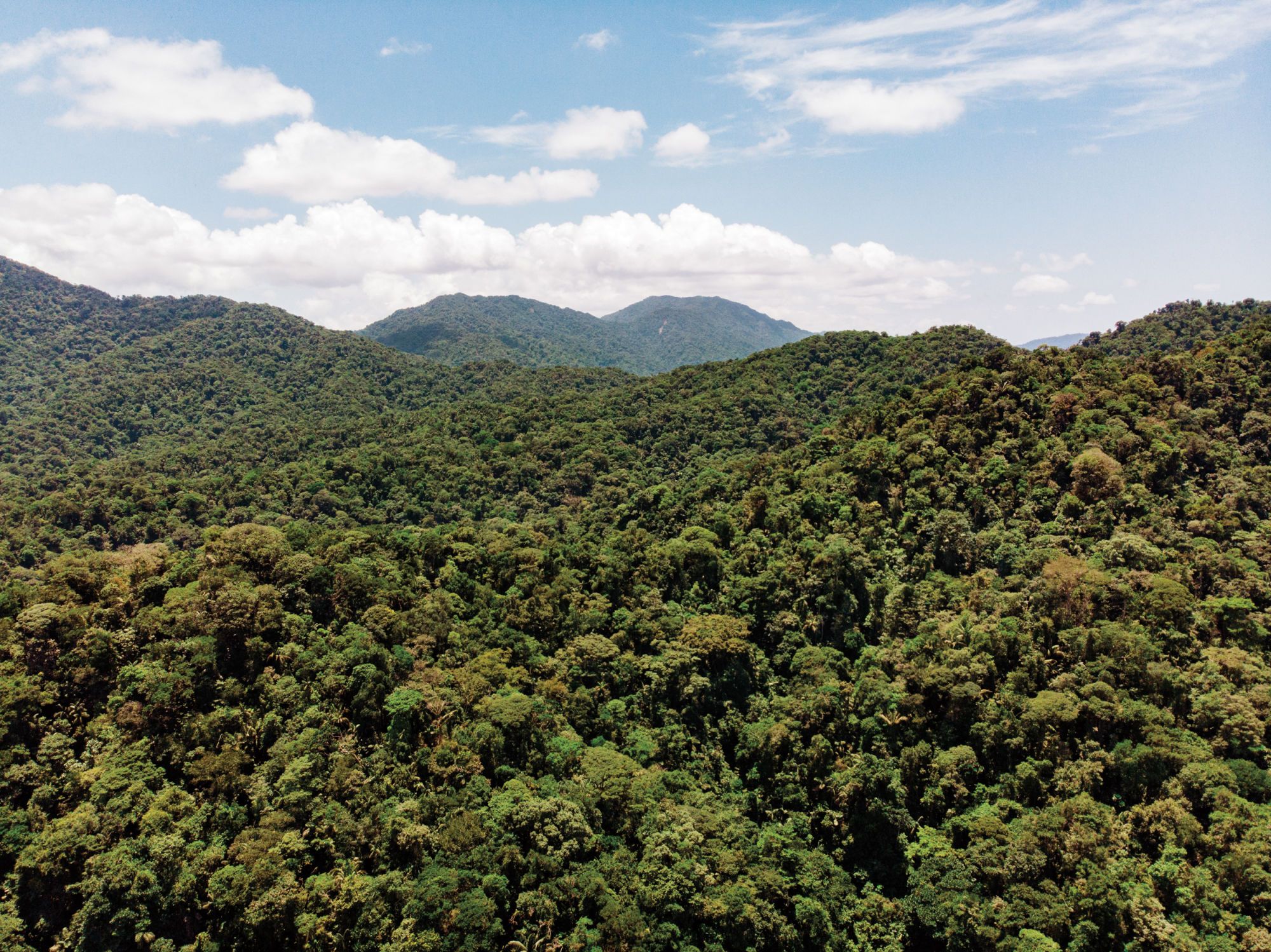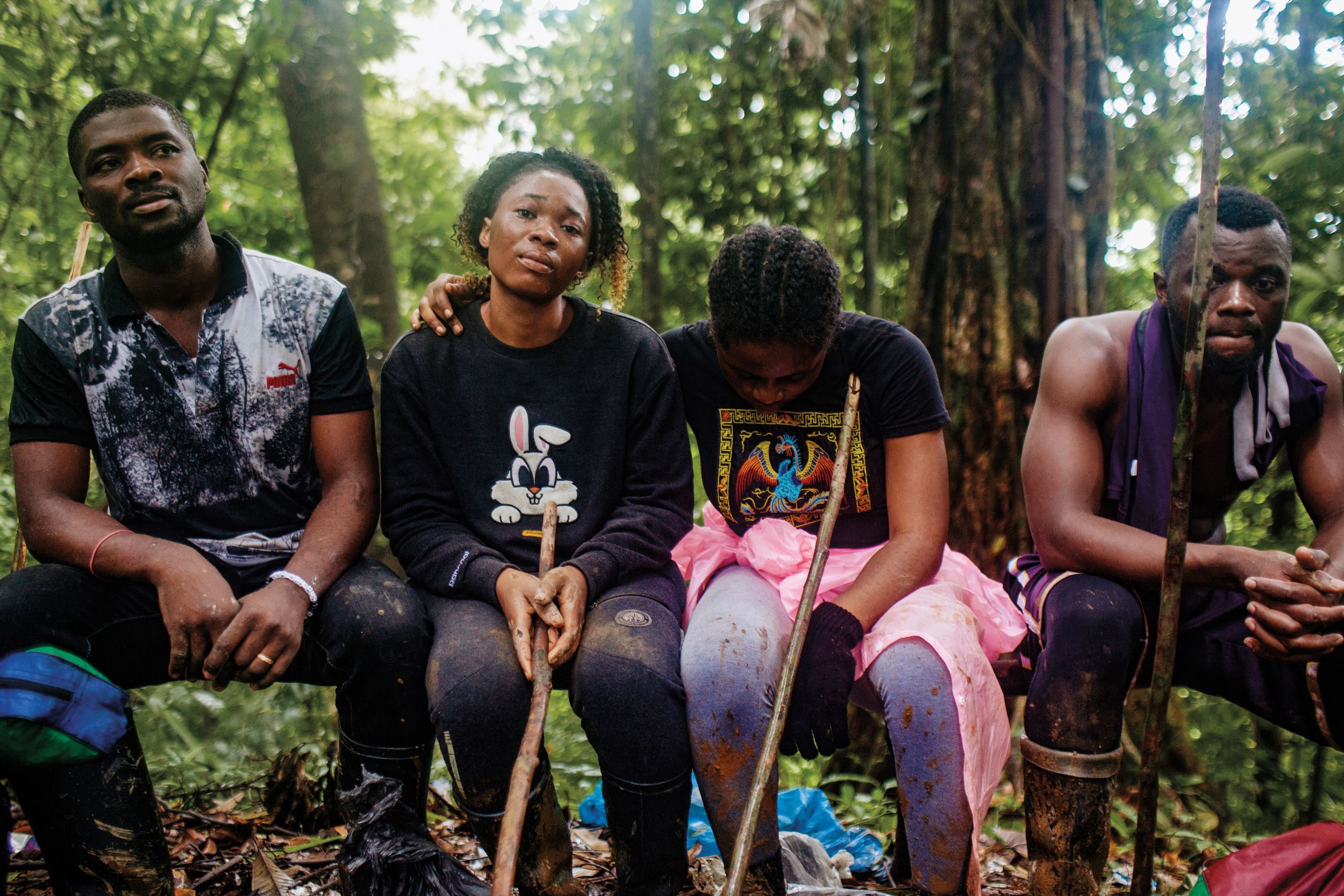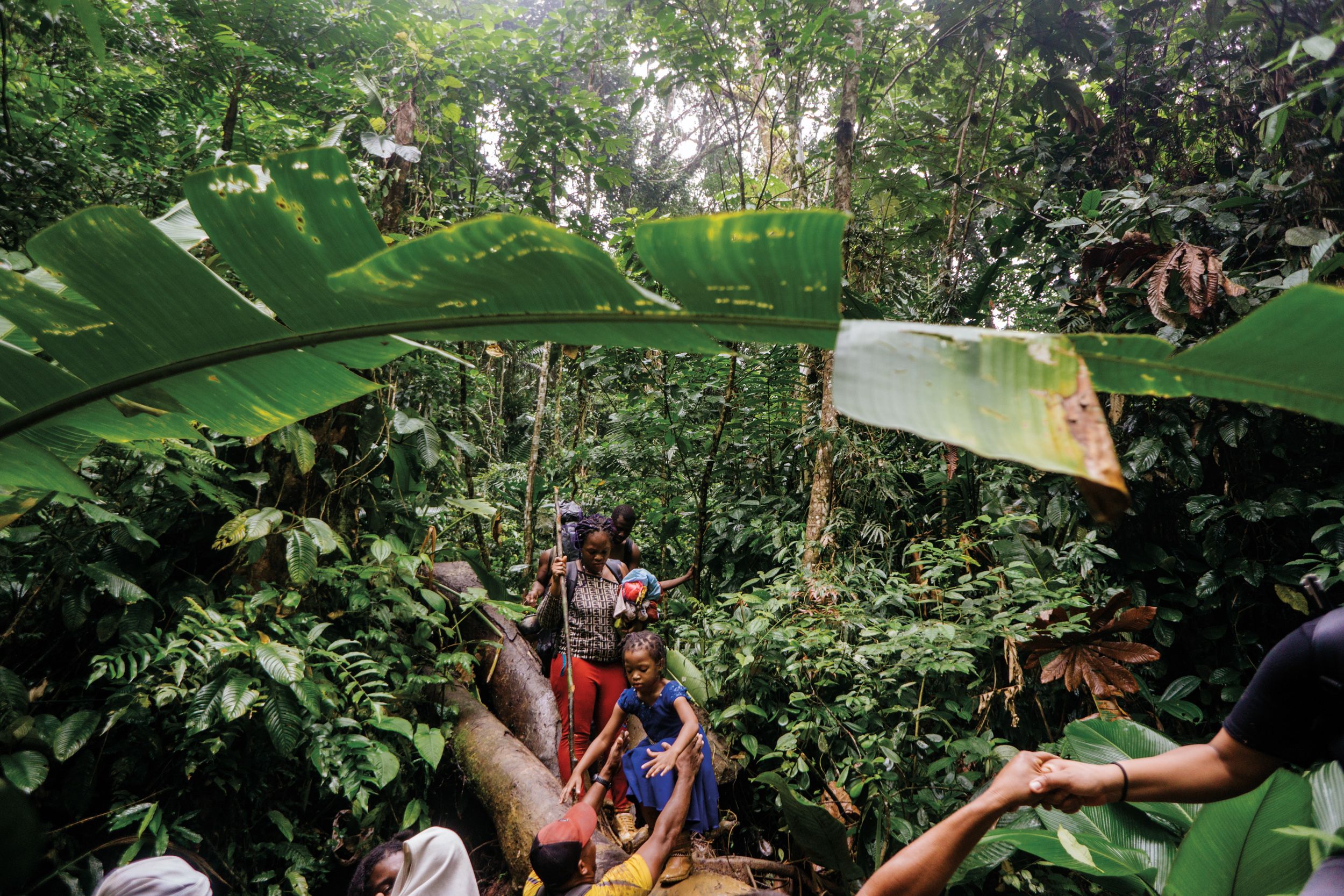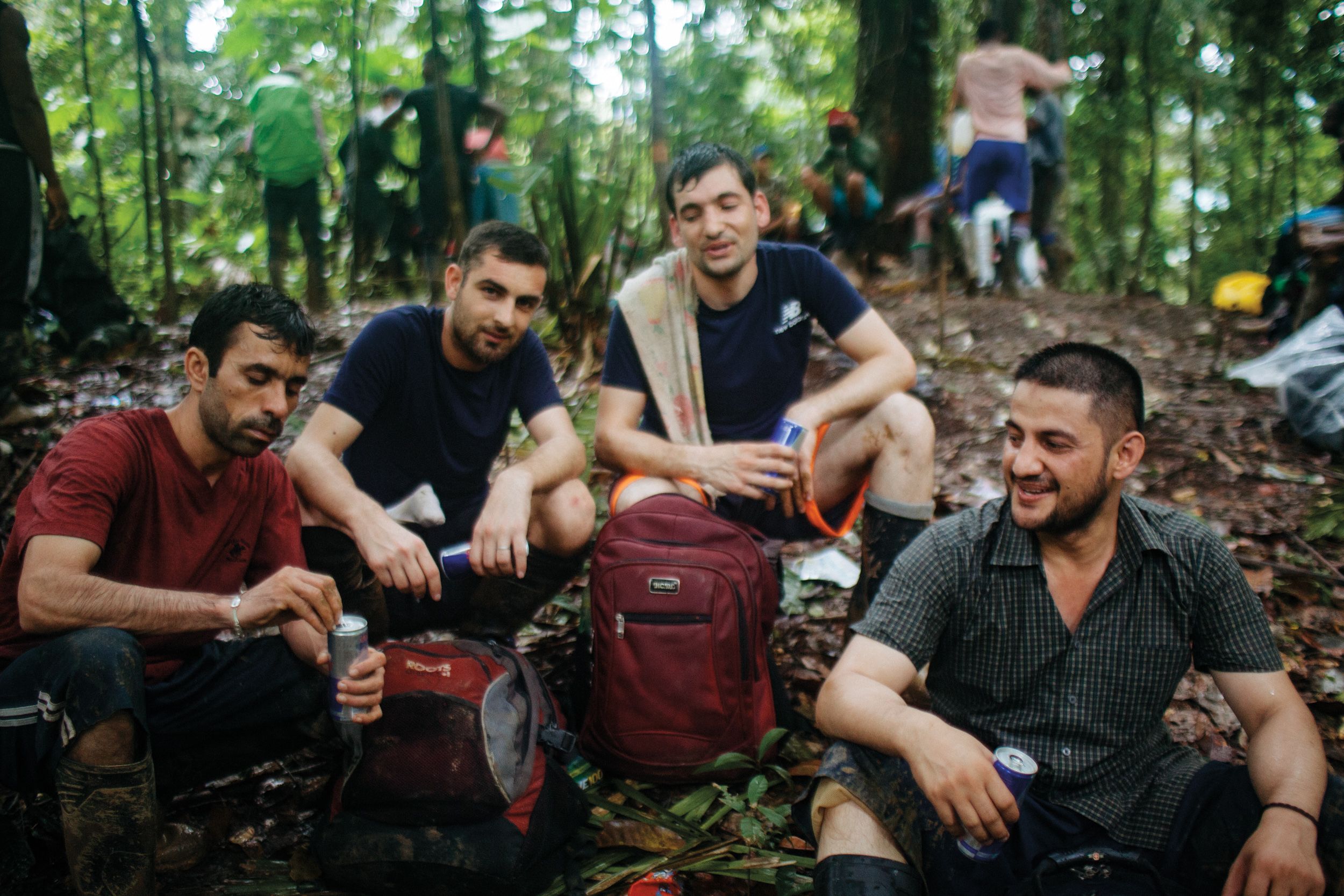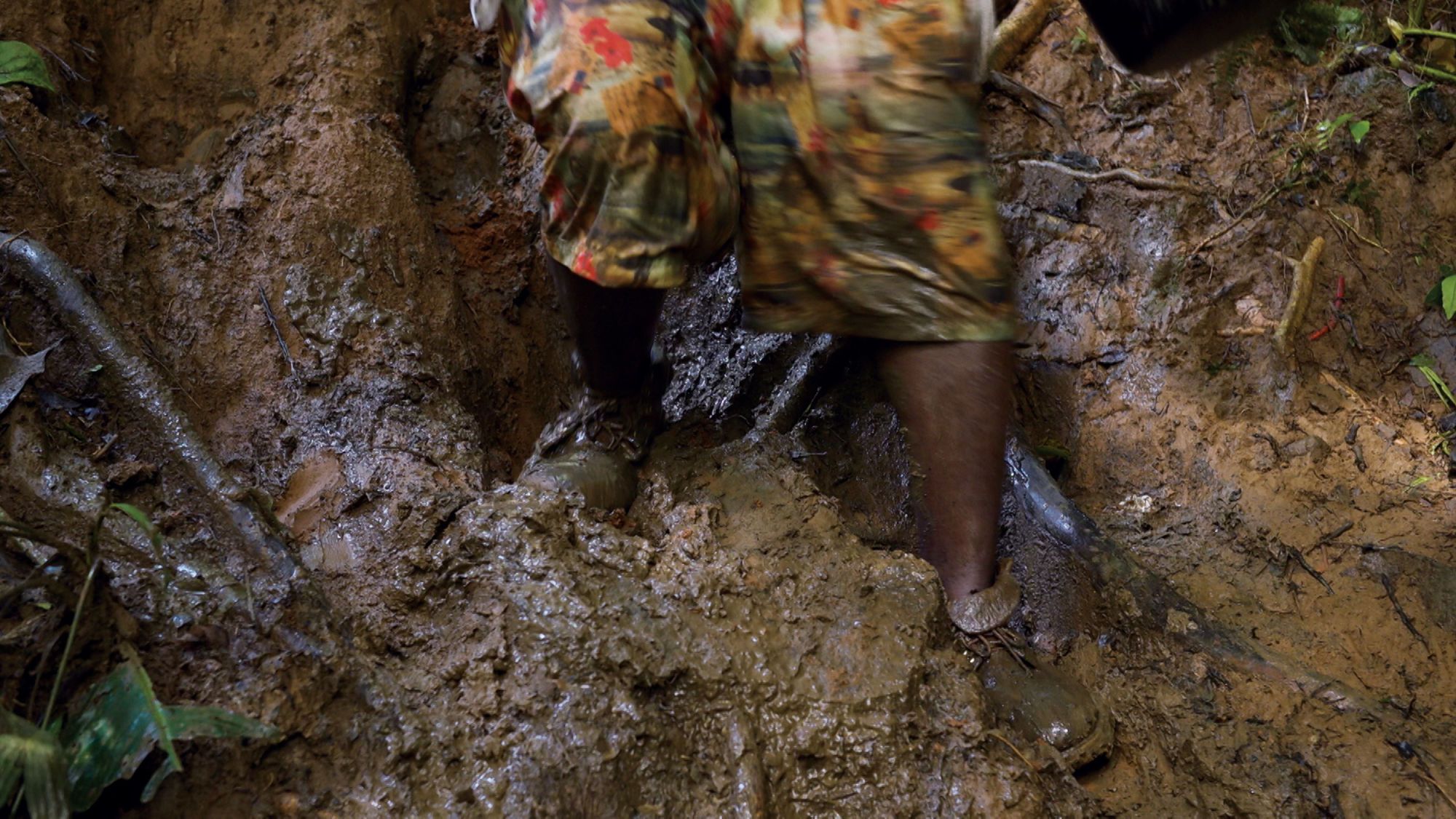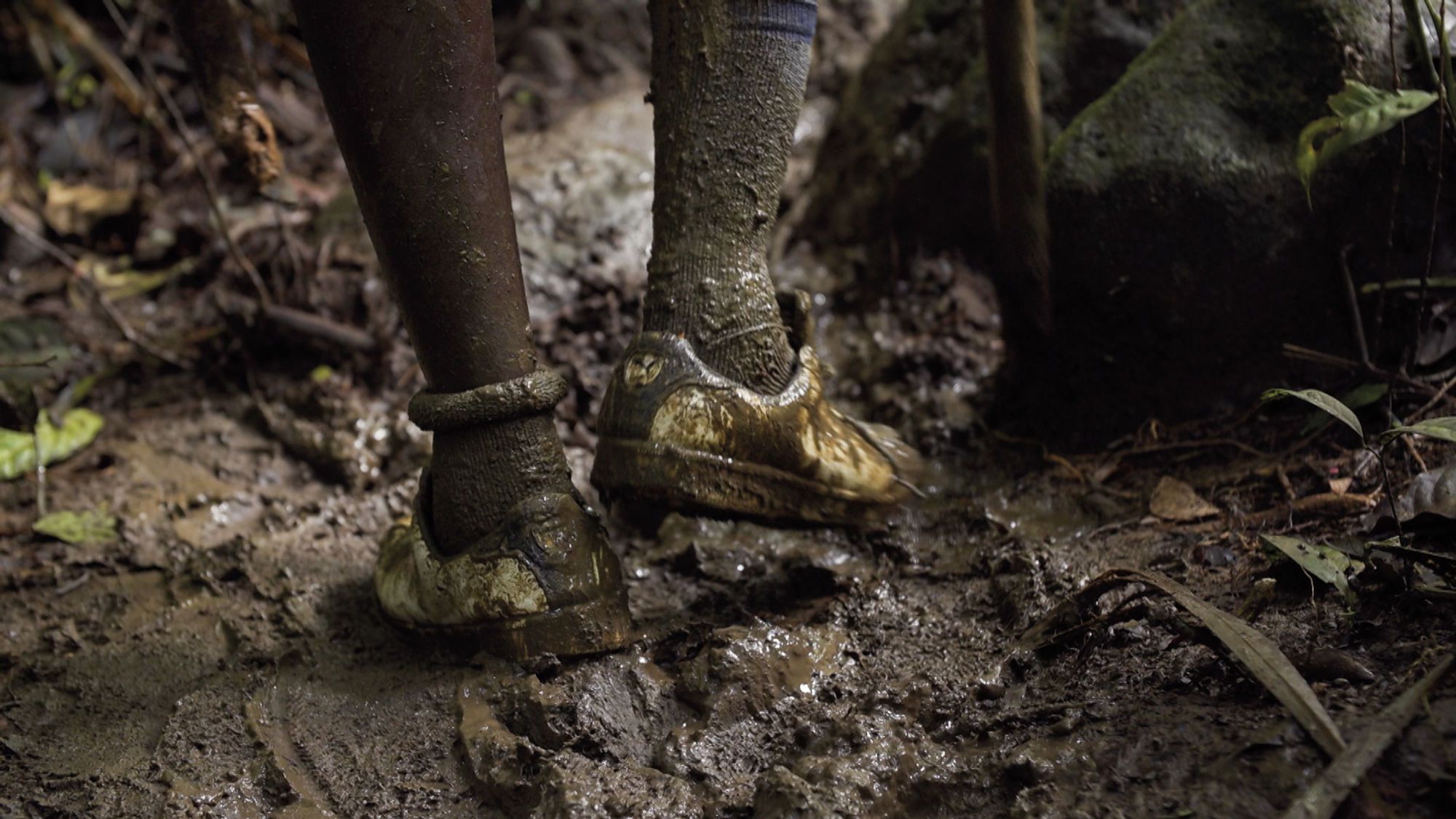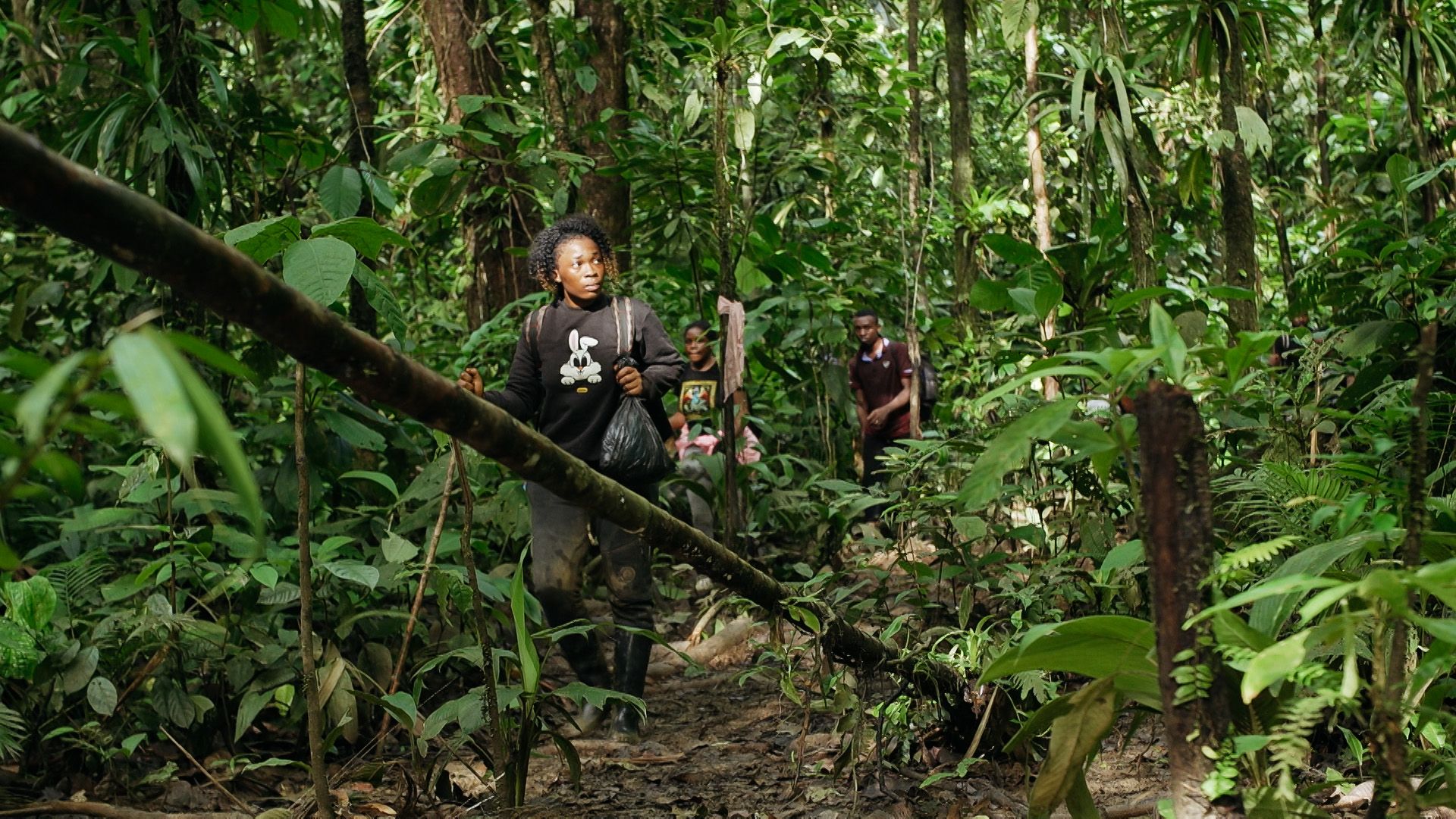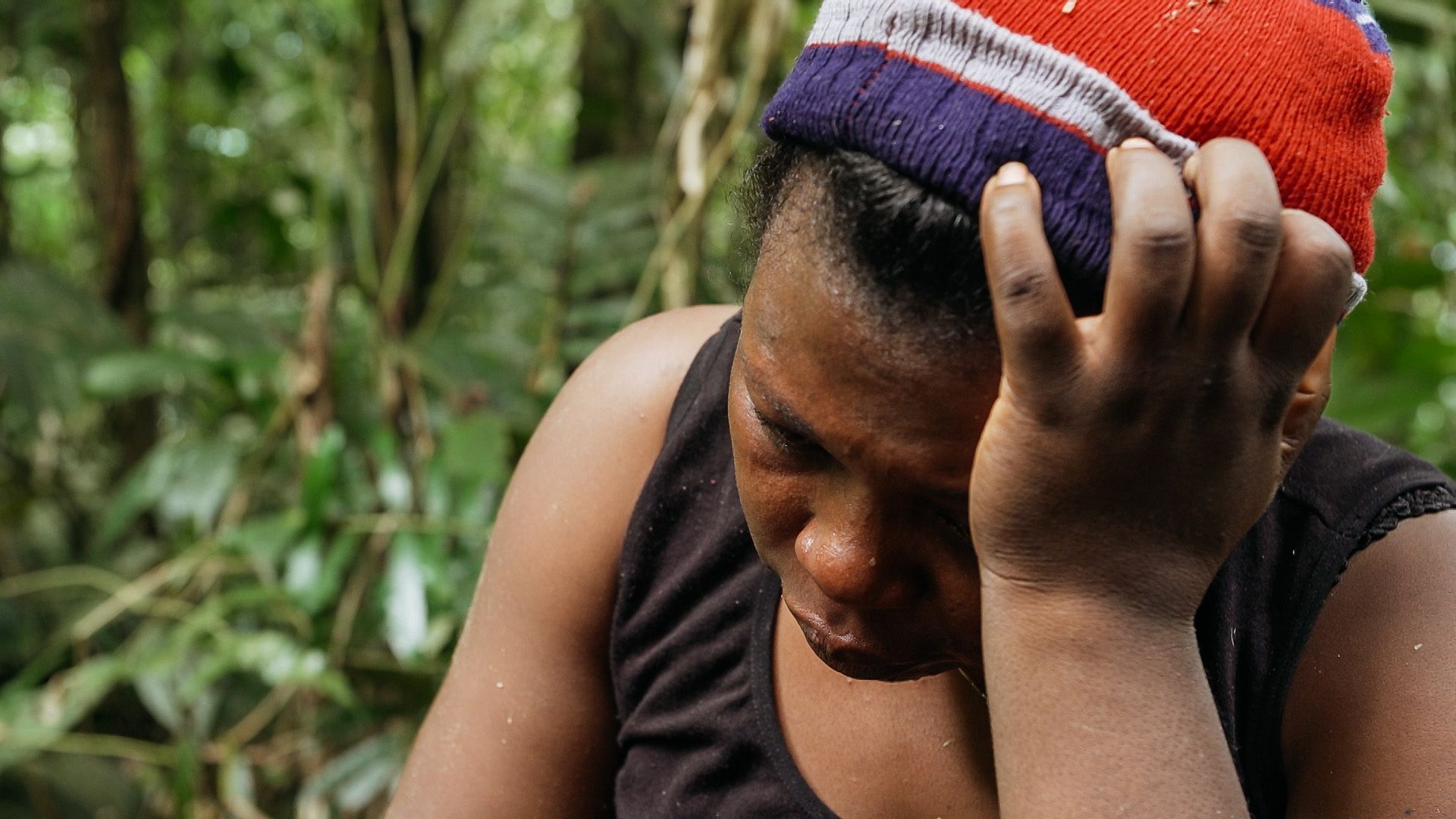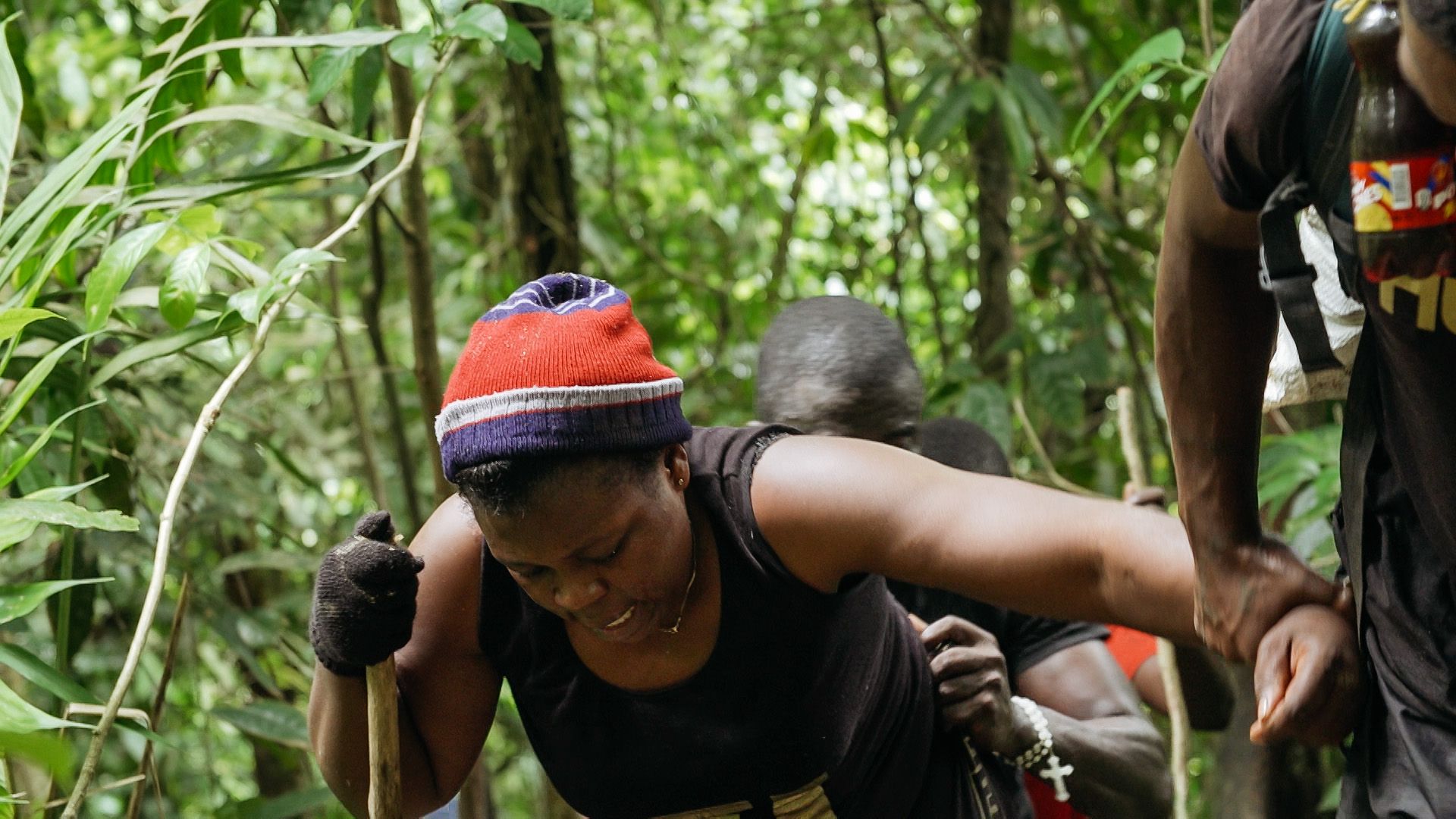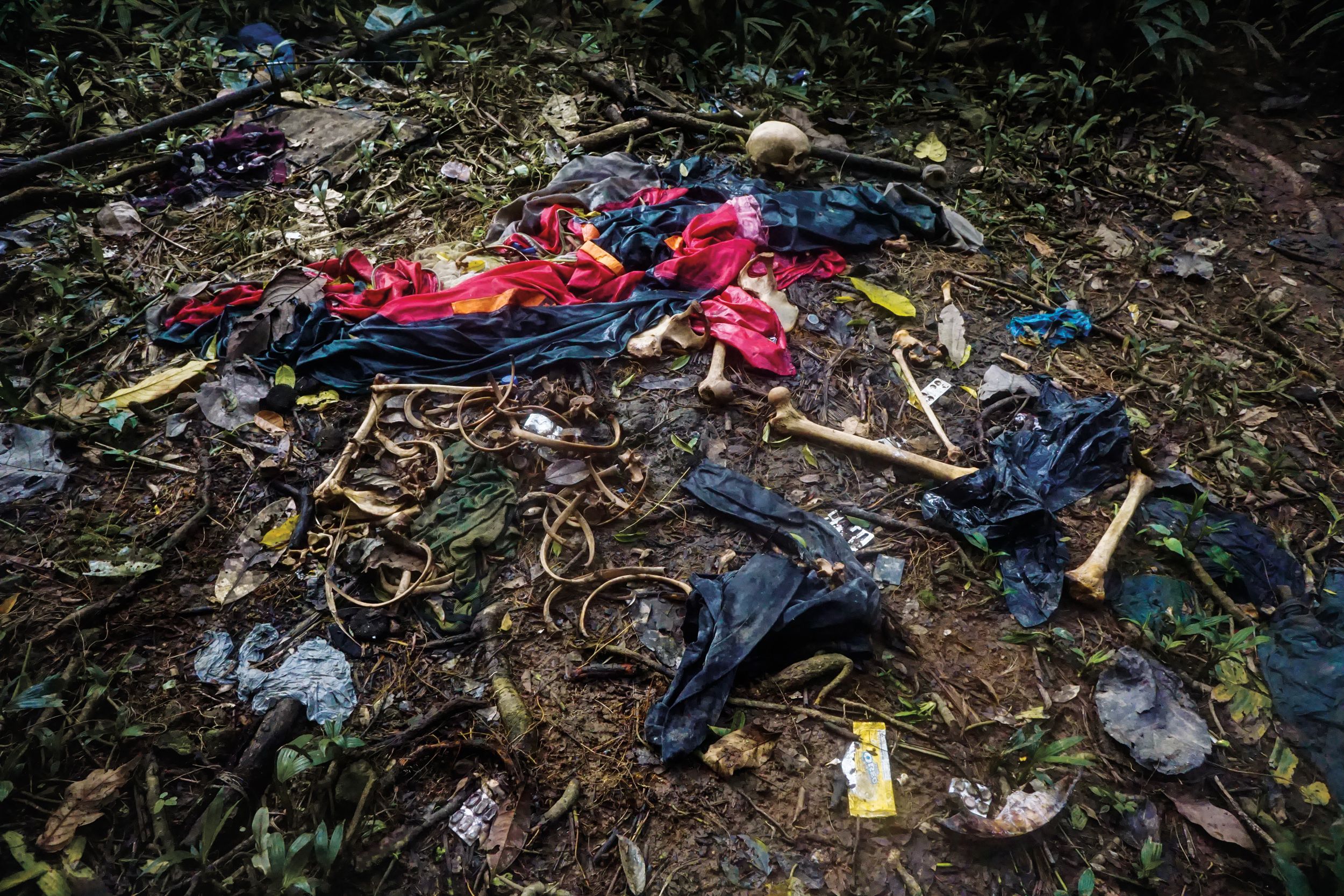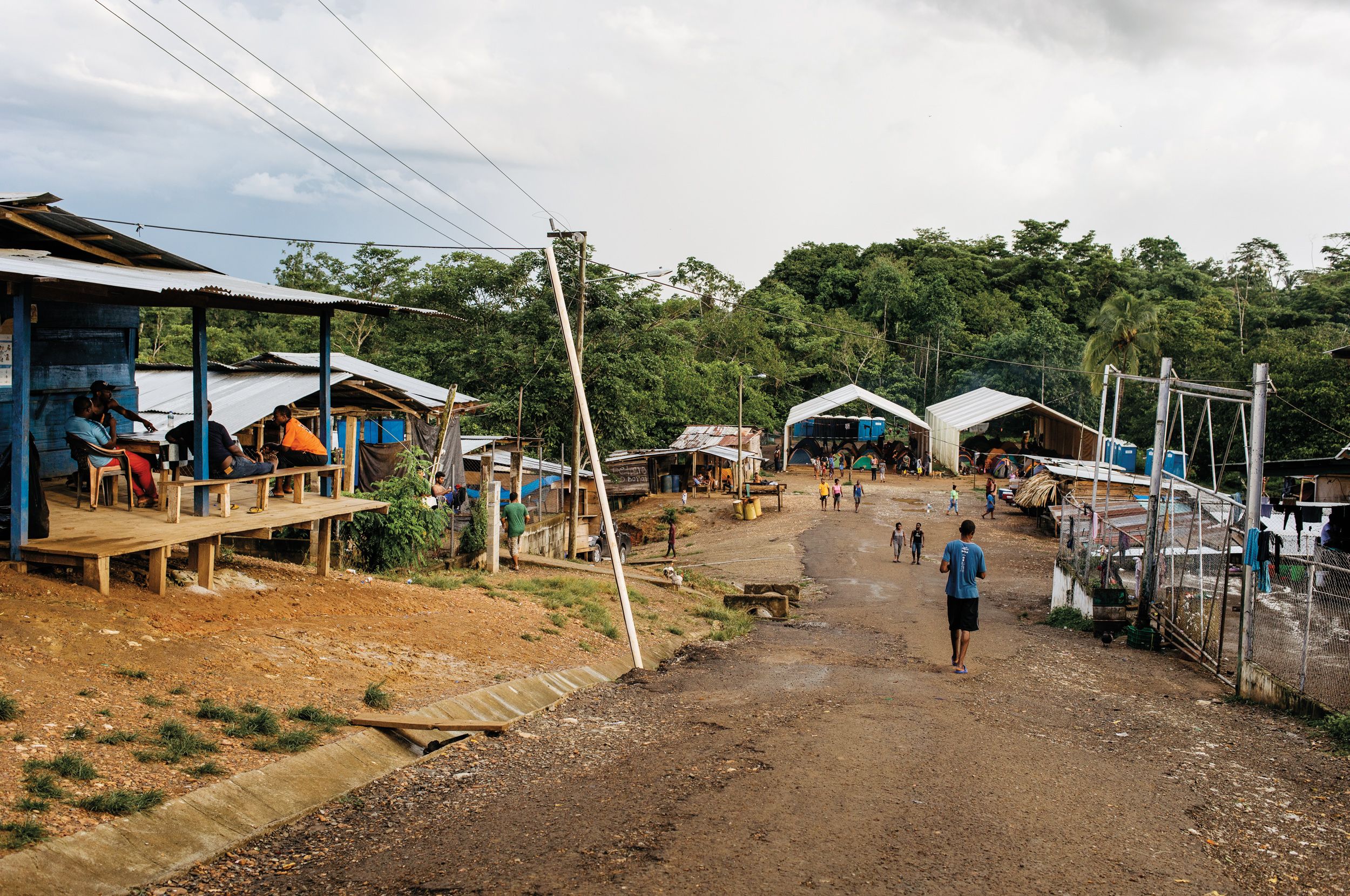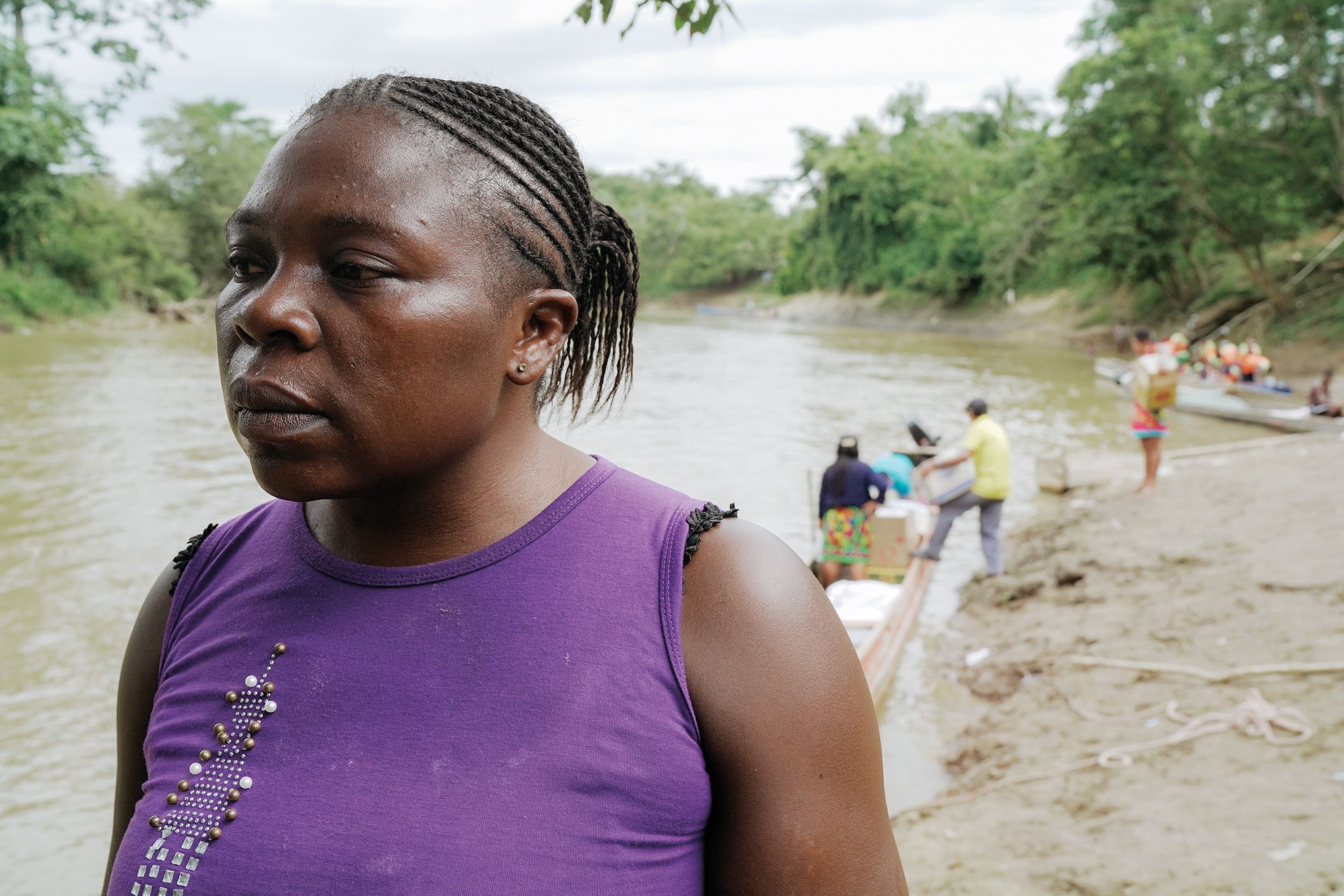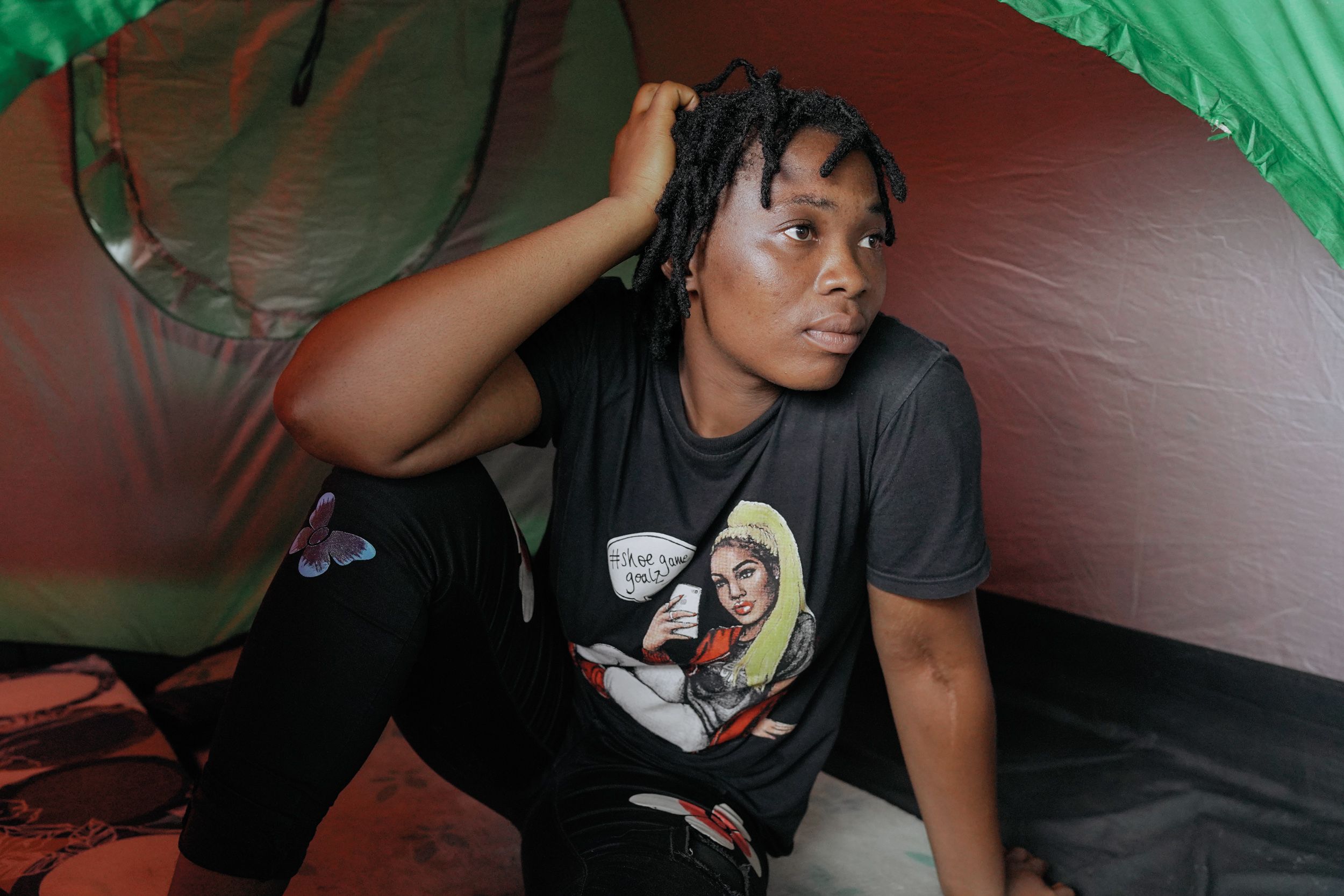Dusk was descending through the rainforest when the Cameroonians and Pakistanis stumbled into the campsite. They were in their 20s and 30s and loaded down with knapsacks, tents, and shoulder bags. Mud covered their rubber boots. They looked dazed, trying to make out who was occupying the small clearing that had just opened up in front of them.
The site was not much to speak of, a patch of dirt dotted with stumps and discarded pieces of tent fabric. Several men lay in hammocks that hung between slender trees. The one extravagance was a kitchen, shaded by a tarp and consisting of a rough wooden table, a couple of open fire pits, and some blackened pots that rested on rocks.
The four Pakistani men, the first to arrive, were breathing hard. Most of the Cameroonians — there were 18 in all — made straight for a nearby river, their plastic passport holders dangling in the water as they doused their faces. Some stripped off their clothes and washed themselves. A woman named Sandra stood motionless, in obvious pain. Twenty-three years old, she was one of the youngest in the group. Tight ringlets, their ends a rusty blond from old highlights, framed her face. Wrenching off her knapsack, she sat down on a log and hugged her knees. She was worried about her friend Benita, who had twisted her knee the day before and had been struggling. When Benita limped in, leaning heavily on a thick branch, Sandra looked up. “How many more days?” she asked to no one in particular.
Sandra and her group had set out two days earlier from northwestern Colombia and had walked at least 15 miles on steep, unforgiving trails across a swath of land known as the Darién Gap. Straddling the border of Panama and Colombia, the Gap is approximately 10,000 square miles of dense, mountainous rainforest and marshland. There are no roads. The only way around it is by sea. It has long been considered one of the most dangerous regions in the world: a corridor for drug trafficking and home to jaguars and venomous snakes. This has not stopped thousands of migrants from Africa, South Asia, the Middle East, and the Caribbean from traversing it in the hope that they will reach the United States.
The Pakistanis and Cameroonians were brought to the camp by a smuggler they’d hired in Colombia. Smugglers use the camp as a way station, a place to hand off migrants to other coyotes who will guide them deeper into Panama. This was all part of an elaborate, clandestine system that most migrants barely understand. Many have no idea how long it takes to cross the Darién.
The Cameroonians had gone through almost all of their food, and they started to crowd around the kitchen. Rice and chicken in the middle of a rainforest was an unexpected luxury. When some grabbed plates, a smuggler slapped their hands. The cook held up five fingers: “Five dollar!” A Cameroonian man pulled out a $100 bill and paid for Sandra’s and Benita’s plates. Everyone called him “Pastor.” “I like to talk about God a lot,” he explained, laughing. Before he left Cameroon, he said that God had revealed to him that the journey would not be easy and that he would need to shepherd his people. They would encounter armed robbers, and the armed robbers would attack many groups but not Pastor’s. They would see many dead bodies, but he should not be afraid. Pastor was compact and muscular and over the previous two days had become one of the group’s leaders. Pastor said everyone now needed to eat and rest.
Sandra wanted to know: “When can we really rest?” No one had an answer. She asked for pills, any kind of pills, not for something in particular but because she hurt all over. Benita, who was sitting beside her, could feel her leg stiffening. One of the Pakistanis offered camphor ointment that a Cameroonian started rubbing onto her leg. As he reached her knee, Benita cried out and slid down from the log, her companions pinning her as she writhed in pain. Hours later, when everyone was asleep, one tent glowed orange. Pastor’s silhouette appeared, kneeling in prayer.
From the time of the Spanish, explorers, engineers, developers, and adventurers have tried to conquer the Darién. All have failed. As wild as the Darién is, it’s never been void of humanity — indigenous peoples have been living there for thousands of years. An attempt to establish a Scottish colony in the late-17th century ended up almost bankrupting Scotland. The area would later draw the attention of surveyors who assumed, because the isthmus is only 110 miles wide, that it was a logical place to cut a canal that would connect the Atlantic and Pacific. The Darién continued to prove inhospitable. In 1854, a party of U.S. Navy engineers got lost looking for a canal route, seven of them starving to death. When the Pan-American Highway was constructed in the 1930s, the only piece never completed was the Darién. The missing 66-mile link came to be known as the “Darién Gap.”
Starting in the 1990s, the Darién provided cover for Marxist FARC guerrillas and a faction of the right-wing paramilitary. Because it sits on the border, the Darién was an important route to move weapons and drugs, and its isolation and absence of government authority made it an ideal place for armed groups to operate. In addition to fighting one another, these groups punished anyone who ventured in without permission. Over the years, missionaries, orchid hunters, and backpackers were kidnapped, and, in 2013, FARC rebels killed a Swedish tourist they suspected of being a spy. Today, the FARC has retreated from the Darién, thanks to its peace deal with the Colombian government. The paramilitary officially demobilized in the mid-2000s, but many of its factions reorganized into drug-trafficking groups. The largest of these, the Urabeños, now controls entire sections of the Gap.
The Cameroonians and Pakistanis didn’t know any of this history when they arrived in South America. All they knew was that to get to the United States they had to first cross into Panama, and the only way to do that was through the Darién.
The Cameroonians belonged to the country’s English-speaking minority and were fleeing one of the world’s most underreported terror campaigns. Tensions between the Francophone-led government and its English-speaking citizens date back to independence, but they reached a new pitch in 2016, after the government imposed French-speaking teachers and lawyers on Anglophone schools and courts. Peaceful protests were met with military repression, which gave birth to armed insurgency, which led to further government repression, a cycle of violence that continues unabated. According to Human Rights Watch, security forces have committed torture, carried out extrajudicial killings, and torched scores of villages. By the end of last year, the conflict had left an estimated 3,000 dead and displaced about 700,000 Cameroonians in the English-speaking regions.
Almost every one of the Cameroonians who arrived at the smugglers’ campsite had experienced horrific violence. Sandra was at home eating dinner with her family when the military broke open the door and dragged out her brother and shot him. When they set her house ablaze, she ran into the bush, where government forces raped her. It was the last time she saw her family. Security forces also killed Benita’s brother. She was in the room next door when she heard the gunshot. She rushed in and found him lying on the floor, his head “scattered,” she said. “I tried to gather his head,” but there was no way. A few weeks later, security forces came to the house again. This time she was not there, and she knew she had to flee, leaving her three children behind. Pastor lived in the bush for two months with his 5-year-old son after his mother and father were killed. While searching for food, he was swept up by the military and, although he managed to escape from jail, he never saw his son again.
With Europe and the United States taking strict measures to keep out migrants and asylum-seekers, finding safety abroad had become more difficult. But there was still a way to get to the United States. A few South American countries, notably Ecuador and Brazil, had relatively lax entry requirements, busting open a route through the Americas. Unlike the passage across the Mediterranean, whose dangers were well-known, few images existed on the internet of migrants who had drowned or been murdered crossing the Darién Gap. Benita decided to fly to Ecuador but had no idea what she would do after she arrived. On a layover in the Istanbul Airport, she found some Cameroonians who told her that after Ecuador, they were planning to go to the U.S. “I asked them, ‘Can you walk there?’ They said, ‘Yes.’ I said, ‘Huh? So after Ecuador is the United States?’ They said, ‘Yes, you will just walk. You pass through the river, you enter the United States.’ ”
When Benita arrived in Ecuador, she met Pastor and Sandra and found that many Cameroonians were armed with tips on how to get to Colombia’s northern coast: which towns to hit, where to switch buses. As more and more Cameroonians fled the country, this kind of information had gone global, one WhatsApp message at a time, as people were getting pushed out of places like Sri Lanka, the Democratic Republic of Congo, Angola, India, Bangladesh, and Eritrea. In 2019, Panamanian authorities counted almost 24,000 migrants, more than three times as many who had crossed in 2017. While more than half were from Haiti, the number of Africans and South Asians has continued to grow significantly.
The four Pakistanis got together for the first time in a bus station in Lima, Peru. They had been making plans to go through the Darién for weeks. Waseem and Hussain had arrived from Pakistan, Nihal and Wajid from Chile, where they had worked for a year. Three of them came from the Swat, the region near the border with Afghanistan. They had lived through the violent years of the Taliban and the military offensives to root it out, and they were eager to move to a safer country.
Through family and friends, Waseem was the common connection among the four. He was fair-skinned, with a neatly trimmed beard and light green eyes and not unaware of his good looks. South America and the Darién had never occurred to him. When he left Pakistan, he flew to Dubai with the hope of getting a visa for Europe. He soon realized that was unlikely — few European countries were welcoming 23-year-old Pakistani men without a job lined up — so he settled on a country that would give him a visa: Peru. When his flight landed in Lima, however, immigration authorities informed him that his visa was invalid and that they would be sending him back to Pakistan. According to Waseem, he immediately fainted and, upon waking in a hospital, told security officials he would rather stay at the airport than return home. Twenty-two days later, authorities granted him a temporary visa, and soon he was living with the Peruvian woman who had guarded him at the airport and talking to his friends about meeting up and heading for the U.S.
For migrants traveling north through Colombia, the road ends in Necoclí, a port town on Colombia’s Caribbean coast. From there, boats shuttle across a bay to Capurganá, a sleepy tourist town that serves as the gateway to the Darién Gap. It was on one of these boats in late summer that the Pakistanis and Cameroonians met and talked about what lay ahead. They were sure they could traverse the Darién swiftly — they were young; they had brought no kids. As the boat skipped along the waves, they decided to cross the Darién together.
When migrants get off the boat at Capurganá, young men pitch them like tour operators: “Amigo, amigo. Panamá, Panamá.” Along the boardwalk, restaurants try to outdo one another, blasting music from loudspeakers. Massage tables and plastic chairs dot the beach. The same shops that are stuffed with flip-flops, snorkeling masks, and bathing suits also sell machetes and tents. There is an easy rhythm to the place: Tourists come; drugs and migrants leave.
The Urabeños, the narco-paramilitary group that dominates the region, tolerate the migrants as long as they don’t interfere with their drug trafficking or draw the attention of authorities. It is an uneasy coexistence, and when the flow of migrants threatens their activities, the Urabeños have taken action. According to locals, the group killed a smuggler to make an example of him after some coyotes defied a ban the Urabeños had temporarily imposed. Recently, word spread, they had executed a smuggler for raping two Cuban migrants. It’s hard to know how far the Urabeños’ control extends into Panama, but because that control includes the northern entrance into the Darién, the group dictates who enters and who doesn’t and how much they have to pay.
Upon arriving in Capurganá, some migrants think they can take a bus or boat to Panama and are shocked to find out they have to walk. Many haul trolley suitcases or duffel bags so stuffed they can’t be zipped closed or appear in winter jackets with fur-trimmed hoods, in leather shoes, or dress pants. By contrast, the Pakistanis had found videos on YouTube that showed people trudging through mud and had bought rubber boots and rain ponchos and made sure to pack cookies, dried fruit, nuts, and a liter of milk each.
Most don’t speak Spanish and are at the mercy of smugglers. The Cameroonians had come with a reference and a photo for a man named Junior, whom they found soon after they landed. For $50 a head, he would fix them up with guides, as the smugglers prefer to be called, who would bring them into the jungle and across the border to a place he simply referred to as “el río,” the river. There was just one more charge, Junior explained — a mandatory $20-per-person fee to ensure their safety from the “mafia.” The Cameroonians didn’t know who the mafia was, but they had already heard that the bandits in the Darién killed anyone who didn’t give up their possessions. So everyone paid up. Junior then took a photo of each Cameroonian and Pakistani, and, with the transaction complete, they headed out of Capurganá, the smugglers leading the way. Some time later, they reached a gate. A group of men counted them off, one by one, and ushered the 22 migrants into the rainforest.
On the morning after the Cameroonians and Pakistanis arrived at the smugglers’ camp, they woke up to torrential rain, which was turning the ground into a field of puddles. Wind ripped tarps from their fastenings, causing them to flail. Wajid, one of the Pakistanis, clutching an airline blanket around his neck, sprang up to futilely grab the corners of the kitchen tarp. Others scrambled after tents.
The constant wetness was one of the hardest things for the group to get used to. Dampness from exertion and humidity, from brushing up against leaves, seeped into everything — sweaters, underwear, blankets. It brought a chill to the nights. Because the group crossed so many rivers, everyone was always wet up to their waist. Their boots would fill with water, and even after draining them, their feet would slosh around. The skin on their soles sometimes peeled off until they bled.
Rather than hiring a new guide, the group had decided to stick with the same one who had taken them to the camp. He had shown unexpected consideration, hoisting them up over tree roots and occasionally carrying a bag. For $10 per person, he would lead them another day. There were only two ways to make money, he said, if you were a 30-year-old and lived near Capurganá: carry drugs or carry migrants. He opted for migrants. His brother had run cocaine on trails like this and been shot by the Panamanian police and now lay in an unmarked grave. In the two years he had been guiding migrants, he said he had seen suffering that would “break anyone’s soul.”
After the storm subsided, the group set off, many in pink, yellow, and blue ponchos; they looked like candy drops. Some of the smugglers who had been waiting around the camp decided to join the caravan. They knew the Cameroonians and Pakistanis would tire out, and they buzzed around, offering to carry their bags for a fee. The trail leading out of the camp went straight up a mountain, one slope turning into another and then another. This went on until midafternoon, everyone trudging past ferns and hanging vines on a trail that was like a shaft walled in green. Through the canopy of trees, the sky would appear intermittently in small patches. When the Pakistanis reached a clearing, they cracked open a Red Bull as they waited for the others to catch up. Sweating under her plastic rain pants, Sandra soon joined them. She had left Africa under the impression that the journey to the U.S. would be simple, that she would be able to do it alone. “I never knew that you will climb mountains upon mountains upon mountains,” she said.
Benita lurched in last, supported by Pastor and a lithe Cameroonian named Vitalis. Barely able to bend her knee, she moved by swiveling her hip. This maneuver didn’t work when the trail turned steep. Then she had to bend her knee, stake her rubber boot, and lift herself up, which sent shards of pain shooting up her leg, and she would let out a howl. Pastor would push her from behind while Vitalis would pull her up by her hand. They did this for hours. Whimper, cry, heave.
The descent was even harder. The migrants would slip and lose their balance, grabbing at a branch or a vine to break their slide. Somewhere near the top of the mountain, Benita had started to feel as though her leg had separated from her body. She now had the vacant expression of someone who was disassociating from the pain. A guide called Camilo* watched her struggle. “This is how it starts,” he said. “Most people who injure themselves die.”
Down a nearby ravine, a migrant he had known lay at the bottom of a tree. Flesh still covered parts of the skeleton; bits of fabric clung to his pelvis. Camilo referred to the dead man as the “Hindu,” which is what smugglers called anyone they decided was from South Asia. The Hindu had arrived at the smugglers’ camp two months earlier in terrible condition, and Camilo said he advised him not to keep going. But after a few days, the man decided to continue. Halfway up the mountain, he couldn’t go on. He had an injury similar to Benita’s, Camilo said.
Over the next two weeks, smugglers and migrants would see the man along the trail, crawling and resting, and would give him food and water. One day, a smuggler passing through heard the man calling for help — he had fallen down an embankment. The smuggler, according to Camilo, couldn’t lift him out on his own and came back some time later with others to carry the man to their camp, but when they called out for him, there was no answer.
Among the four of them, the Pakistanis could manage basic English and Spanish and could communicate somewhat with the guides and understand what was going on. They rarely got despondent, and, while hiking, their conversations would often turn to the U.S. — how they were going to get there and what life must be like. The Pakistanis couldn’t stop and perform their afternoon prayers on the trail, but at camp they used a river for ablution and airline blankets for mats. They asked God to protect them, Waseem said, from all forms of harm, “whether human or animal.” At night, the four crowded into their tent and could always be heard bantering. Waseem jeered the others for having brought only one tent for all of them; they teased him for talking like he was the oldest.
At one point, a group of men came up from behind the migrants, thrashing through the underbrush in their rubber boots. They were swift and agile; it was clear they had taken this route many times. They were carrying boxed backpacks loaded with bricks of cocaine and slowed only to slap hands with a guide. The Pakistanis were so focused on the trail, they didn’t even look up when the drug runners passed them.
When the Pakistanis reached the river at the bottom of the mountain, they dipped their bottles and drank with a fever — it was the first time they could refill them. It was a beautiful spot. The river was narrow, and the canopy opened up just a slit, enough to let the late-afternoon sun fall through the bowed branches, dappling the water. The river ran gentle and shallow here, and the Pakistanis took off their socks and let the water wash over their feet.
Sandra removed her rubber boots and chugged back an orange powdered drink. No one had eaten anything all day, and the Pakistanis and Cameroonians were passing around crackers and nuts. One of the guides beckoned to Sandra to give him nuts. She guffawed at the audacity of his demand and held up two fingers, signaling $2. Despite his pleas, she insisted, and he zipped open his hip-pack to get the cash.
The Cameroonians had thrown away much of their food the first night on the trail. Pastor acknowledged the decision was rash but explained that the first day had been so arduous that everyone just assumed they were close to their destination. It was as if by refusing to accept how long the journey was, the Cameroonians could will it shorter. They had even gotten rid of a Cameroonian staple called garri, which Benita, Vitalis, and others had brought. Made from ground cassava root, it’s what sustained many in the group when they were hiding from security forces in the bush.
For the guides, the river was the end of the line. The chances of being apprehended by border police increased the longer they stuck around on the Panamanian side, and the consequences were extreme — years in prison for human smuggling. The guides told the migrants to follow the river, wished them good luck, and turned back up the mountain. Only later did the Cameroonians discover that some of the guides had rifled through their bags. Benita’s purse was missing; she didn’t have any money for them to take, but she lost her rosary and passport. Pastor’s small bag with his passport had also been stolen, but not his Bible, where he hid his cash in a slit sealed with super glue.
The Cameroonians and Pakistanis were now on their own. There are only a few ways for migrants to know whether they are headed in the right direction. There are trails, of course, but it’s easy to end up circling back, days later, to where one started. Trails can also disappear at a river or a rock face. The best signposts are those that other migrants have deliberately left behind: torn pieces of plastic or cloth tied around a branch to indicate the correct path. More evidence would appear that they were following others — a child’s knapsack, shoes, empty sardine cans. But then there were the essential items left behind: tents draped across bushes, poles jammed between rocks in the river. Had migrants discarded them because they had been lied to, as they often were, by smugglers who told them they were less than a day from finishing?
After resting, it was hard for everyone to gather the energy to keep going, and a half-hour later, the group stopped at a small opening that had been used as a campsite. It was a good location — high enough above the river so that if there was a flash flood, the site wouldn’t be washed away, which was not an unusual occurrence. The smugglers had talked about how, after a rainstorm, they would find bodies of migrants, sometimes as many as a dozen, still wrapped in their tents and scattered among the rocks downstream.
The group debated whether to stay. A Cameroonian named George, who had been limping badly, was adamant they should. The Pakistanis wanted to stop as well, but they were outnumbered. As one of the Cameroonians argued, being without food wasn’t “relaxing.” The group needed to keep moving while there was still light. The Pakistanis had made a deal with the Cameroonians that they would stick together. Honoring their promise, they filed out. Nihal said he hoped they’d find a suitable place to sleep before dark. “Inshallah,” God willing. A couple of hours later, they stopped for the night, but George and his friend Mohammed failed to show up.
The next morning, another group came across George hobbling along a riverbank. Tall and muscular, he was wide-eyed with fear. He explained that his ankle injury had caused him to fall farther and farther behind. Mohammed had remained with him but in the morning had dashed off to reach the others, taking their tent with him. George had tried to follow, hopping on one leg while leaning on a walking stick but had slipped and dislocated his shoulder.
“Even his own people left him behind,” the lead guide of the group said, shaking his head. George was too big to be carried, he declared. There was nothing to be done, except pop his shoulder back into place, give him provisions, and wish him luck.
The guides could surely come back for him at night, George asked, once they had dropped their packs? He would pay them well. No? Well, at least they could carry his belongings for him until he’d catch up with them at their campsite, because he was certain he would, he said. The guides agreed to carry a garbage bag of nonessentials for him, but George was so confident he’d make it that he put his food, including two cans of tuna the guides had given him, into the bag. When they insisted he keep his food, he became flustered, repacking. As he transferred documents and pills into his knapsack, he became frantic with questions. “Where do I sleep at night?” he asked over and over. “How will I do it?” No one responded.
The lead guide cut him a new walking stick with a hollow shaft, instructing George to stuff his cash inside and plug the opening with mud. Another guide slit his T-shirt with a machete and wrapped it around his shoulder as a sling. George got up and started making his way out on one foot until he had to pull himself over some large rocks. Soon, he was crawling.
It took hours for Mohammed to catch up to the group. The previous night, a couple of Cameroonians had gone back a half-hour on the trail to look for him and George, shouting their names into the darkness. In tears, Mohammed told them what had happened, that George could not walk, and he doubted he could make it out by himself. The group didn’t even have to discuss what to do. George was a day behind, and they were low on food. They had to keep going. “There was no turning back,” Vitalis said later. If they lost one of their friends to the jungle, how would they feel? Pastor wondered. He told everyone they needed to pray: They needed to ask for forgiveness for abandoning George, “because what we did was bad.”
As they pushed ahead, the Cameroonians rarely talked about what had happened back home. “When we are moving, we are talking about what is at hand, not your life,” Vitalis said. But their minds went there. When Sandra sat down to rest for a moment, alone on the trail, she fell asleep, not sure she wanted to wake up. “I did not see any ending,” she would later say. All she saw was green; it made her eyes feel weak. In her sleep, she heard a voice imploring her to keep moving: “Sandra, don’t give up. Don’t give up. Go,” and she opened her eyes and started walking. She would never feel fear again on the walk.
Unlike the other Cameroonians, Sandra had a precise destination: a two-story apartment complex in Huntsville, Texas. That was where Ellerton, her fiancé, lived. He had left Cameroon for the United States on a student visa in 2016, when Sandra was in her second year of law school at the University of Bamenda. He had been active in organizing marches and strikes, which made him a target of the police, who had detained him several times. One night, he and Sandra heard gunshots near their home. They ran to the back of the yard and hid in the only place they could: the outdoor toilet. Within minutes, the military started shooting up the house. The next morning, they escaped the city, and a month later, Ellerton was on his way to the United States. Sandra returned to her family’s village, where she thought she would be safe.
Fatigue and despair would also overwhelm Benita. She couldn’t shake what she had seen in Cameroon; it gave her what she called “my problem in my mind.” Images of her brother splayed out on the floor, his head in pieces, would suddenly rush in. The realization that she did not know where her family was would strike her with such force she would cry out. Running from one bush to another, she realized, had become her life. “She was moving and crying, moving and crying,” Vitalis said. She told him once that she wanted to remove all her clothing — they were more than she could bear. Another time, she told Pastor, “I will go inside the river.” You know why you left Cameroon, Pastor told her. “If you die here, your family will never see your body.”
When the Pakistanis offered Benita nibbles of food, she would turn them down. She stopped caring, she later said, because of all the death she had known. Remembering made her breathe fast. Her words would sputter; tears would stream. “I have passed through a lot of pain that I cannot carry,” she would say.
On their fifth day, Pastor woke up with a revelation. It would be their last day walking, he declared. It was true that the terrain began to change as they made their way. The river they had been following merged with two others, and it broadened, offering wide, pebbly beaches. The sky suddenly opened up and became big. When they turned their heads back, the migrants could see the mountains they had just crossed; it was as if the Darién was spitting them out into flatlands.
There was another sign that they were reaching the end: The number of corpses began to increase. There were the corpses that were visible — the ribcage splayed on a rock, the rotting body shoved off to the side of the trail, the skull beside the river. Some of the Cameroonians spotted a new-looking tent off the trail, thinking they might take it for themselves. When they opened it, they discovered three bodies. “We ran,” Vitalis said. The bodies kept piling up.
“We entered here,” Benita said, “we meet corpse. We go this way, we meet corpse. We come back inside the water. We enter the river. We come out. We continue just like that.” There was one body — half a body, without its torso and head — that struck Benita with such terror, she screamed and bolted, despite her knee. When she looked at it, she saw what she could become. Pastor yelled at her to slow down, that she would injure her leg, but Benita was off.
Then there was the death that they couldn’t see but that clogged their senses. It was the fetid smell seeping through patches of brush. It was the vultures circling and squawking overhead. Seeing the bodies, Wajid said, “immediately, we got energy.” When night fell, they kept on going, even though they were without a flashlight. “We walked like I have never walked before,” Pastor said.
Eventually, they met a couple of men with horses, who offered, for a fee, to guide them to an indigenous village called Bajo Chiquito. One man led, while the other took the rear, lifting Benita onto his horse. The group followed a muddy path until the man in the lead said he couldn’t go any farther or he risked being arrested for helping them. He assured them, though, that they were only a half-hour away from where they could cross the river and head into the village. Benita would later say she had no recollection of how she got to the river. All she knew was that she fainted along the way. “I don’t know whether I come by horse,” she said, “or they carry me. I just discovered myself by that water.” No, Pastor said, she did not faint. She couldn’t remember because she was overcome with exhaustion — “That means she wants to die because the journey is more than you.”
The river was shallow. On the other side, in the distance, the Cameroonians and Pakistanis could see lights. “Euuushh, God!” Sandra exclaimed. She was so happy, she took off her boots and walked barefoot, crossing the river one last time. As the group approached Bajo Chiquito, the din of crickets and birds of the jungle night receded, replaced by the hum of a generator and barking dogs.
The Cameroonians and Pakistanis stayed in Bajo Chiquito for only a few days before they boarded motorized canoes for La Peñita, the village that serves as the processing center for migrants coming out of the Darién. It is a pin-drop of a place with a smattering of cinder-block and clapboard homes and barely more than 100 permanent residents. When the group arrived, the village was housing more than 400 migrants, mostly in tents and hangars. (On occasion, there have been as many as 1,200.) Authorities had also converted a large warehouse into a dormitory, but they were having difficulty keeping up with the influx. Only a dozen portable toilets served the camp, and much of the time, they were too full to use.
Migrants proceed to a trailer, where they hand over their passports and have their irises scanned and fingerprints taken with equipment provided by the United States. Officials then submit the information to the U.S.’s biometric registration system; on occasion, someone from the American Embassy comes down from Panama City to conduct an interview. Most migrants are vetted within a week or two and then wait their turn to board a bus that will take them to a camp on the border of Costa Rica. For migrants from countries the United States has deemed of “special interest” — countries thought to produce or harbor terrorists — the wait can take months, though.
This was the reality dawning on the Pakistanis. They were renting a three-room house with other Pakistanis, which they kept immaculate, leaving their flip-flops by the door. They had bought thin roll-out mattresses, a floor fan, and a couple of cooking pots. Every day, they would sit on a plastic tablecloth laid on the floor and roll small balls of dough to make chapati. They had never made the bread before — it had been the domain of their mothers and sisters — but it was one of the few activities they could undertake that connected them to their families.
Wajid wasn’t angry that he had to submit his biometric information, but he was frustrated at how long the vetting would take. “We are happy, but we are very disappointed,” he said. The treatment vexed Hussain. “What is the crime of the Pakistani people? Why is it happening to Muslim people? Because of my nationality or something else? I am not a Taliban.” They were now thinking about going to Canada instead of the States. Waseem had an ex-girlfriend living in Toronto. She had been blocking his phone calls, but, his friends laughed, that was no deterrent.
One day near the riverbank, Sandra, wearing ripped black jeans and an embossed sweatshirt, appeared radiant. With a borrowed phone, in one of La Peñita’s patches of internet signal, she had managed to reach Ellerton. He had cried with relief to hear she made it through the Gap. He would be waiting for her in Texas, he said. In the meantime, he would send her some money for the trip. Wouldn’t it be incredible, she wondered, if she, too, would be able to study in the United States? As she talked, she would sometimes shade her face with her hand to hide how giddy she was.
Escaping boredom and heat, the Cameroonians would often lie on mattresses under the rooftop that extended from the dormitory. One afternoon, Pastor was sitting with Sandra, Benita, and another member of their group, Sandrine, on the mattresses. He had been ill the day before and was worried that he had contracted malaria, but the pills he’d received to fight parasites seemed to have revived him. He was going on about a video he had seen on social media of a Cameroonian boy about 4 years old, standing alone on the dirt ground looking for his parents after an attack on his village. The atrocities in his country — they were beyond understanding. That was why, he said, the Cameroonians always seemed so forlorn: They may have left their country, but they couldn’t shed their lives there.
As he talked, Benita was silent, staring off into the distance. She often looked detached. “My soul is somewhere else,” she said one afternoon by the river, where migrants were washing clothes and bathing. Benita felt as lost in time and place in La Peñita as she did elsewhere. When she was hiding in the bush in Cameroon, one day blended into another. She didn’t know how long she had spent there: It could have been two months; it could have been six. She was certain about the day her brother was murdered — December 8, 2018 — but that was it. The Darién had plunged her into another vacuum of time. “Since I left Cameroon, I don’t know. I no longer know days or months,” she said. She often dreamed about her family. One night, she saw her 5-year-old son reaching out to her. Another night, she saw her mother standing across the river. “Mother, mother, I’m here!” she called, but her mother couldn’t hear her. The dreams filled Benita with sadness. “What should I do now?” she asked. “I don’t even know my life now.”
One day, an Angolan arrived with his wife and two young children. His name was Gedeao, and he had been worried about taking his family through the Gap, but he wanted to give his children a better future. The journey had taken 14 days, and it was a nightmare, he said: “I lost my daughter.” The family had been crossing a river. The current wasn’t especially strong. “I don’t know what happened,” he said, looking down at his hands that had lost their grip on his 9-year-old girl. After scouring the river for two days, the family gave up. Bandits had already robbed them of everything, including their food and the $2,000 he and his wife had saved to get to the U.S. By the time they reached Bajo Chiquito, they hadn’t eaten for days. We have nothing, he said, except for the blankets and diapers the border police had just given them.
An officer had spoken with him about where his daughter had been swept away — perhaps they could retrieve the body. But Gedeao didn’t see the point: How would having his daughter’s remains help his family? He tried to explain what might appear to some as heartless: For his family’s sake, he had to find a way to outlast what had happened. Mourning had no place on this journey.
As the Cameroonians and Pakistanis shared their experience with other migrants, they came to realize how extraordinarily lucky they had been. A couple of days behind their group, ten Bangladeshi men had been robbed four times; stripped of their tents and food, they had gone three days without eating before finding another set of migrants. Bandits had robbed a Haitian woman and her boyfriend, who watched as one of them put his fingers in her vagina, searching for any dollars she may have hidden. Another Haitian had been murdered in front of his group. Sandra learned that two women a few hours ahead of her had been raped. Stories and rumors circulated continually throughout the camp; migrants assimilated them, and they became a collective memory. One of the few pieces of good news was about George. In Bajo Chiquito, the Cameroonians had pooled together money to hire a couple of horsemen to look for him. They had gotten word that the men found him, and, after two weeks in the jungle, he was recuperating in Bajo Chiquito.
A week after they arrived in La Peñita, Sandra and Benita and some of the others in the group were told they’d be on the next bus to the Costa Rican border. Pastor, though, would catch up with them later. He wanted to go to the hospital in the next town and be examined. The Pakistanis came to say goodbye. In broken English, they expressed gratitude for having gone through the Darién together. Benita thanked them for helping her. “You guys are very good,” she told them, her face beaming.
Pastor said he was curious about the Pakistanis’ country. Was it as beautiful as they said it was? But he worried, if he brought a black woman, how would she be treated? The conversation turned to what a Cameroonian-Pakistani baby would look like. Would it be black or white?
“Black! Black is beautiful!” Sandrine declared amid lots of giggles.
It doesn’t matter, Hussain told Pastor. You will be in America. “It will be a black-and-white baby!” he exclaimed to bursts of laughter.
“Brother, see you in America!” Pastor promised. With that, Sandra and Benita, clutching $40 for the ticket, boarded the bus for Costa Rica.
